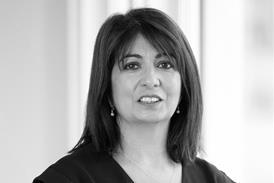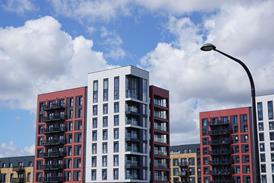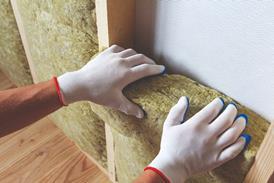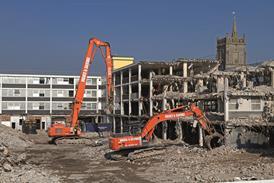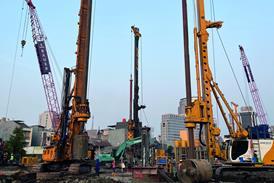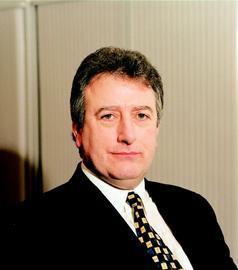One is able to make such unflattering observations in the knowledge that the building's pedestrian veneer is in marked contrast to its tardis-like interior: lofty labyrinthine circulation spaces topped by curved timber ceilings and flanked by snaking open-plan offices. And everywhere white walls, bare cedarwood and copious amounts of daylight.
But it is not the paradox of subdued architecture and spectacular interior design which makes this building so intriguing. Indeed, its appeal even goes beyond its heavily automated mixed-mode ventilation and radiant chilled ceiling system. The vital message from this project is the progression it represents away from the vast air conditioned 1980s open-plan office to a more flexible and humane working environment.
Designed in 1996 and completed in the summer of 1998, the 7432 m² two storey, concrete-framed office building is the second phase in the expansion of Marks & Spencer Financial Services (M&SFS) at Chester. The first phase, an 11 000 m² fully air conditioned building, was constructed in 1988 on Chester's budding business park as the headquarters for the direct investment, credit, insurance, pensions and charge-card provider.
Despite strong and committed facilities management and high quality staff amenities, phase I's variable air volume air conditioning and insular, chocolate-glazed envelope has never been a big hit with its pc-based staff. It was either too hot or too cold, and there were regular complaints of draughts among the mostly sedentary female workforce. The building's services have also proved expensive to run.
It isn't all bad news. The staff certainly appreciate the high quality finishes and particularly the focal point of the atrium. But if only we had more control and openable windows, they said, plus better use of daylight and more views of the outside world, then we would be much happier.
All these considerations went into the brief for the phase II design competition. This drew an entry from multidisciplinary Building Design Partnership (BDP) which was strongly based on the socially responsive form of architecture then under construction for the School of Computing and Information Systems at Sunderland University1.
Designed by BDP architect Chris Harding, the building impressed Marks & Spencer's Robert Colvill with its mixed-mode environmental engineering and asymmetric mix of office, circulation routes and meeting spaces, all wrapped up in a Scandinavian style of interior design. This seems to have dragged and clicked well into Marks & Spencer's view of the contemporary office. The modernist atrium of phase I has been replaced in phase II by a more active social node in the form of a busy cafeteria, while the boxy deep-plan office space with its serried ranks of desks has been replaced by 15 m deep, narrow-plan office wings.
These have been cranked through 45° to create sub-communities – a nightmare for the suspended ceiling contractor, but worth it for the visual interest it gives the offices. The building's low elevation and articulation help create a softer visual impact on the landscape.
Project scope
BDP was commissioned in 1995 to provide an initial masterplan study of the site and to develop the brief with M&SFS for the detailed design of the phase II offices. BDP's responsibilities also covered the extension of the central catering facilities, remodelling of the loading bay, provision of a covered link between the two buildings and extensive landscaping, including a new lake at the centre of the site.
At this time the M&SFS engineering team received strong project management support from its retail parent company, although as the construction progressed M&SFS gradually assumed more control and authority.
BDP was novated to the main contractor Laing North West – "an excellent relationship" according to BDP project engineer Andrew Swain-Smith – the designers producing coordinated drawings beyond that normally expected of abridged duties. The m&e specification is based around the M&S approved suppliers list, with negotiation over critical items like the chillers – DeLonghi packaged units which have pleased everyone.
Despite height restrictions imposed by the local authority, Chris Harding maintained an east/west broad barrel vault with two slivers of motorised skylights to both illuminate and extract air from the building. Much of this zone is hogged at high level by a broad, half-timbered bulkhead which houses the air handling units, a chiller compound and the heat raising plant. As a result daylight penetration is adequate rather than copious, but is compensated by the sheer glazed, double-height cafeteria at the west end.
The usable accommodation divides broadly into two types: double aspect offices (mostly of open-plan but with the provision for cellular) and core facilities, including social spaces and meeting rooms, generous toilet provision, a lift and stairs.
There is no main entrance as the building is linked at ground and first floor level to phase I via a covered walkway. This provides access to the northern office wings and connects via bridges to the amenity building and south-facing wings.
The principles governing the design of the office space were that it should be a comfortable, efficient and welcoming working environment. Staff, said M&SFS, should be as close as possible to a window and be able to enjoy the benefits of daylight within the constraints imposed by glare and solar control.
The architecture and services engineering design addressed these issues primarily by opting for the narrow plan (15 m) office plates. With a (clear) glazing ratio of around 50% on all elevations, occupants enjoy good daylight penetration and views out across the countryside. Of course the narrow floor plate also gave the potential for natural single-sided and cross ventilation, of which more anon.
The north and south wings are subdivided by stair cores to create four separate control zones. The co-ordination of the structural grid (7·5 m by 7·65 m) with the windows and the suspended ceiling ensured a large degree of flexibility of space planning.
On the matter of fenestration, the client's desire for unobstructed views had to be reconciled with the need to limit the area of window to make passive control viable. It was also important to create regular perimeter fixing points for cellular subdivision.
The result combines motorised toplight windows and external retractable fabric blinds (Venetian on the cafeteria glazing) with adjustable blades. This is all operated automatically rather than locally by the occupants, so it can be operated in tandem with the comfort cooling and mechanical ventilation systems.
Having operated a fully air conditioned, IT-rich office for ten years, M&SFS didn't balk at retaining central control. Indeed, it is fully aware that its demand for a more socially responsive and energy efficient building has compounded the complexity of the environmental systems as opposed to simplifying them. Fortunately M&SFS is a client which places great emphasis on employee welfare, and has provided a well-staffed and professional facilities team to run both buildings.
When it came to designing the air conditioning BDP had to square the client's conflicting requirements of green and user-friendly systems and a peak internal summer temperature of 2252°C (Tmax 24°C) to match the conditions in the existing building. Occupancy and equipment densities meant that while the building could be designed to operate mixed-mode for long periods, it would also need to be air conditioned during peak external temperatures.
M&SFS shunned the loathed vav system and opted instead for an underfloor constant volume supply backed up by radiant chilled ceilings and perimeter heating. This prevails throughout with the exception of a training suite which has a more powerful vav underfloor system.
BDP thought about exposing the concrete slabs, but there were various technical objections to doing so, not least of which was the client's predilection for a conventional suspended ceiling. Chilled beams were considered but thought far too ugly. Radiant chilled ceiling panels on the other hand were felt to integrate well with a metal profiled ceiling while being able to handle a 45-50 W/m² cooling load. The remainder could be dealt with by the underfloor ventilation system.
The chilled ceilings are the serpentine pipe system manufactured by Trox. Each wing of the building has its own tertiary injection circuit, run at a constant elevated temperature of 15°C, served by the secondary chilled water circuit. Nominal subcircuits have been created by installing motorised control valves on a 1·5 m grid. In the event of future partitioning the valves can be fitted with actuators.
The first three 1·5 m ceiling panels inboard of the office perimeter are fitted with radiant panels. The central zones are kept free to act as the ventilation return path. The ceiling panels themselves were produced as an integrated unit, complete with smoke detectors, category 2 fluorescent luminaires, fire alarm sounders and locations for sprinklers.
A full mock-up of the ceiling system was assembled by Trox in its German factory to test the cooling output of the radiant cooling panels. Much to the manufacturer's embarrassment the chilled ceilings would only produce 41-42/m² cooling output, 10% lower than quoted. This was largely due to the poor connection between the mesh plate supporting the serpentine pipework and the ceiling tile. The solution was to weld six small magnets on each mesh plate to improve contact.
Interestingly, the only way BDP could sign off the performance of the chilled ceilings after installation was to take thermal images of every installed panel.
Ventilation
It is important to reveal that the client specified a whopping 20 litres/s/person fresh air supply rate. Leaving aside for the moment what this means for the building's fan power, it at least contributes significantly to meeting the base cooling load (excluding solar gain), in the offices of 25 W/m². This is lower than one might expect for a financial operation, but while the work is pc-based, it is mostly for telephone-based customer support with little need for local printing and photocopying.
The system is plenum-based, with conditioned air from the barrel vault ahus descending ducted risers between the two wings, and discharging under the floor via constant volume boxes.
Extract is into the internal street, either via the motorised toplight windows (which motor open in tandem with the perimeter toplights when conditions allow) or via transfer fans in the ceiling void. The extract path into the ceiling has been achieved by leaving off the sound insulation from behind perforated metal panels in the tartan grid ceiling.
Air is returned from the street to the roof plantroom for energy recovery prior to being discharged from the building.
Where cellular offices have been erected, the swirl outlets have been replaced by modular fan terminal units incorporating electric heaters to prevent overcooling. These also allow increased fresh air to be introduced into rooms if required, either because of increased occupancy densities or because of higher than average equipment cooling loads.
Operational issues
As befitting a mixed-mode system, the services cycle between different modes of operation depend on time of year and prevailing internal and external conditions.
When outside conditions are moderate, the system operates in an intermediate ventilation mode setting. The underfloor supply system runs at a constant rate to satisfy the fresh air needs of the occupants by supplying tempered air (heated but not cooled) or operating in the free cooling mode.
When outside conditions are suitable, the toplight windows are motored open via the building energy management system (bems) to increase the ventilation rate and improve the perception of the environment within the space. Wisely, local override switches allow each window to be manually closed.
The natural ventilation effect is enhanced by the opening of the roof vents in the street which promotes a cross flow of air in the open-plan office space. In this mode, the street operates as a natural ventilated stack, with mechanically opened louvres at low and high level utilising the natural buoyancy of warm air both to ventilate the space and to draw extract air from the offices.
During high summer, the fresh air supply for the occupants is mechanically cooled. The windows are automatically closed and the external sunblinds lowered to minimise solar gains. Radiant cooling is then provided by the chilled ceiling.
In winter mode the building is sealed and outside air is heated and supplied to the space (at a maximum recirculation of 40%) to satisfy occupants' fresh air needs. Low level natural convective heaters around the perimeter deal with the fabric heat loss, and the dynamic shading devices on the external facade are set to admit the maximum amount of daylight.
Heating of the offices is derived from the perimeter heating system comprising finned tube convective elements at low level. Concealed behind an architectural casing, the elements are supplied from an lphw circuit fed from non-condensing gas-fired boilers – a client choice.
Floor trench convectors are used in locations which have full height glazing, while heating of other areas (stairs, circulation space, stores etc) is by radiators, with exposed pipe coils at high level used to offset heat loss from the rooflights.
For most of the year the coffee area in the street is ventilated through displacement outlets with extract at high level. In summer, when the street is open to outside, this area reverts to natural ventilation.
Ventilation and air conditioning of the general core areas is treated using an underfloor system similar to that in the offices. Toilet areas have a separate extract system and associated make up air supply plant, and each IT riser and associated hub room has a dedicated extract system.
Electrical systems
The hv and lv installation for the phase II building is fairly conventional. Although the building is served by an 11 kV supply from phase I, the brief stipulated that the new building be totally independent for future lettability. New transformers were installed and a third diesel generator added to the two existing units.
Phase II has its own static uninterruptible power supplies. Two 100 kVA units are used to give full protection to the building for about 17-18 minutes to give time for the generators to pick up the load.
In office areas, power, IT and telephone cabling is taken from floor boxes to the equipment on individual desks in flexible wiring via a desk-mounted adaptor. This allows the reconfiguration and addition of equipment without the need to disturb in-floor services.
The power, telephone and IT services to the floor boxes are fed from power busbars and underfloor structured wiring fed from patch panels in the riser cupboards on each floor. The underfloor grid is provided throughout office areas at the maximum possible density, a decision which ensures that both existing and future office layouts have an adequate number of power outlets without the need for any rewiring. All desk power outlets are protected by the uninterruptible power supply.
Power to photocopiers, cleaners outlets and other non-essential equipment is fed from 'dirty' underfloor power supplies. These are kept separate from the desk power and not connected to the ups to avoid electrical interference with IT equipment.
Lighting
Guiding aims in the design of the building were to use as much natural light as possible while controlling glare for the computer users. The street has both direct and reflected natural light, although not perhaps to a degree which would convince those with desks along the inner perimeter of the offices that it is surrogate for an external view.
However, views are maintained to the landscape from the south and west facing offices, and natural light does penetrate deep into the space. In office areas, control of glare through the perimeter glazing is achieved by motorised external solar blinds on the east, west and south facades. These are automatically raised and lowered to suit prevailing weather conditions. Manual internal blinds are provided on all facades for additional glare control.
The office lighting comprises linear fluorescent lamps in category 2 modular luminaires. This fitting has a strong downward component with some sacrificial light projected into the luminiare canopy to control ceiling brightness.
The control gear is of the high frequency digital regulating type, and is fully addressable to allow the electronic reconfiguration of office space for open-plan and cellular use. The lighting system also enables various regimes to satisfy the needs of maintenance and security needs.
Outside of the office and catering space the general feature lighting looks less strategically designed and rather more of an afterthought. A mixture of diachroic and compact fluorescent lamps has been installed in bulkheads above circulation routes and balcony meeting areas and don't appear to be switched according to daylight levels.
Initial performance
The building was completed in the middle of 1998, with occupation running parallel with commissioning, which took place in July and September. Fortunately for such a heavily automated services building M&SFS employs an eight-strong facilities team led by building services manager, Alan Wilson.
The team is demonstrably enthusiastic about running the building and dedicated to responding quickly to staff requests for changes. When operation of the motorised windows was demonstrated for the author's benefit in late December, it didn't take long for the telephones to start ringing – a sure sign that the staff have come to expect fast remedial action.
The team is also conversant with the Andover Controls bems, even if many of the system's functions have yet to be fully implemented. The mixed-mode systems in each wing work to simple setpoints: the outer and inner perimeter toplights open at 16°C and close at 22°C, and the chilled ceilings only operate when windows are closed.
In this mode the fresh air supply throttles back to a predetermined setting. This is currently 50%, but it can be switched off completely dependent on occupant preference.
Rough estimates by BDP associate engineer Andrew Swain-Smith of the building's actual energy consumption (including catering, IT and the computer room) indicate 105 kWh/m² for gas and 325 kWh/m² for electricity. These consumption levels reflect extended hours of operation between 08·00 – 21·00 h seven days a week, with cleaning periods on top.
Inevitably the elevated ventilation rate of 20 litres/s/person will have a impact on fan power, particularly as no specific fan efficiency was specified. Indeed, the supply rate is one of the main reasons why the building did not achieve an optimum BREEAM rating.
As with so many prestige office buildings, service rules and energy efficiency takes a back-seat behind the business process. However, M&SFS realises that fast, responsive and skilled facilities management is vital to occupant satisfaction, thereby productivity.
The high level of building automation, which might be overkill or even seriously counterproductive in a less intensively managed building, is also well within the scope of the facilities team. The cost of running the building might prove to be another matter.
Phase II Marks & Spencer Financial Services, Kings Meadow, Chester Business Park, Chester
Engineering dataGross floor area (gfa): 7432 m2
Net floor area: 5574 m2 Mechanical suppliers
AHUs: Senior Moducel
Axial fans: Woods
Boilers: Potterton
Chilled ceiling: Trox
Chillers: DeLonghi (R134a)
Computer room ac: Liebert (R407c)
Ductwork: Cranworth Engineering
Extract fans: Woods
Fan coil units: Quartz
Hot water calorifiers: IMI Rycroft
Humidifiers: Spirax Sarco
Perimeter heating: Sill Line
Pumps: Pullen
Pressurisation: Pullen
Radiators: Hudevad
Sound attenuation: IAC
Swirl diffusers: Trox
Valves: TAC (UK)
Electrical suppliers
Access control: Thorn Security
BEMS & controls: Andover Controls
CCTV: Thorn Security
Computer room ups: AVK
Electrical accessories: Wandsworth
Fire alarm/detection: Apollo/Morley
Floor boxes: Ackermann
HV switchgear: Yorkshire
Inverter drives: Danfoss
Lifts: Express Evans
Lighting controls: Zumtobel
Office luminaires: Zumtobel
External luminaires: iGuzzini
LV switchgear: Durham Switchgear
Power busbar: Ackermann
Standby generation: Broadcrown Target energy use*
Gas: 100 kWh/m2
Electricity: 180 kWh/m2
*For typical occupied hours (08·00 – 18·00 h, five day week) Estimated actual energy use*
Gas: 105 kWh/m2. For actual occupied hours (08·00 – 21·00 h, seven day week) equating to 58 kWh/m2 for typical office occupied hours.
Electricity: 325 kWh/m2.
For actual occupied hours (08·00 – 21·00 h, seven day week) equating to 179 kWh/m2 for typical offices occupied hours. BREEAM rating
Fabric and services: Very good
Operation & management: Excellent Occupancy
Offices: 1 person/12 m2
Ventilation rate: 20 litres/s/person m3/s External design conditions
Winter: -10°C sat
Summer: 26°C db,19°C wb Internal design conditions
Winter: 21°C ±2°C (>40% rh)
Summer: 22°C ±2°C (no humidity control)
Circulation & toilets (winter): 19°C min Installed capacities
Heating: 660 kW
Refrigeration: 530 kW
Chilled ceiling: 45 W/m2 Loads
Equipment: 15 W/m2
Lighting: 10 W/m2
Occupancy: 10 W/m2 Noise levels
Offices: NR 35
Toilet and circulation: NR 50 Structural details
Slab thickness: 550 mm
Clear floor void: 450 mm
Floor to ceiling height: 3 m
Ceiling zone: 425 Ventilation
Nominal supply air temp: 18°C
Room temp: 2252°C (24°C max)
Max recirculation: 40%
Filtration EU category: EU 3 & 7 Distribution circuits
LTHW: 82°C flow, 70°C return
Chilled water: 6°C flow, 12°C return
Chilled ceilings: 15°C flow, 18°C return Lighting
Lux levels
Offices (open plan): 400-500
Offices (cellular): 300-400
Toilets: 200 Costs
Total scheme cost* (including Phase I upgrade): £19.65 million
Total phase II costs**: £12.91 million (gfa)
Total m&e for phase II and phase I upgrade: £5.11 million
*Excluding VAT and fees
**Excluding landscaping Phase II m&e breakdown
Mechanical services: £1.42 million
Electrical services: £1.94 million
Downloads
Office design
Other, Size 0 kbA simplified cross-section
Other, Size 0 kb
Source
Building Sustainable Design
Credits
Client Marks & Spencer plc Occupier Marks & Spencer Financial Services Project manager & main contractor Laing North West Architect Building Design Partnership building services engineer Building Design Partnership structural Building Design Partnership engineer Building Design Partnership interior designer Building Design Partnership Quantity surveyor Currie & Brown Mechanical contractor Hagen Young Electrical contractor N G Baily




